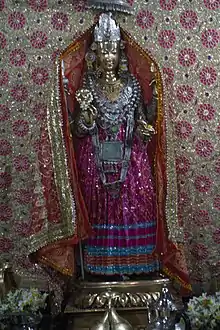Ashtadhatu
Ashtadhatu (lit. 'eight metals'), also called octo-alloy, is an alloy often used for casting metallic idols in Jain and Hindu temples in India.[2][3][4]

The composition is laid down in the Shilpa shastras, a collection of ancient texts that describe arts, crafts, and their design rules, principles and standards. Ashtadhatu is used because it is considered extremely pure, sattvic of Sattva, in Hinduism, and does not decay, as also being restricted to those of Gods Kubera, Vishnu, Krishna, Rama, Kartikeya, and goddesses, Durga and Lakshmi.[5]
Its traditional composition is gold, silver, copper, lead, zinc, tin, iron and antimony or mercury.[6][7][8] However sometimes an alloy idol is termed ashtadhatu, even when its exact composition is not known. The metals were mixed in equal proportions and the finished idol was very rough to be thoroughly polished later on. Due to their sacredness and rarity, these pure idols are often stolen.[9]
See also
References
- Shiv Shakti Devi Temple, Chhatrari
- 9 stolen 'ashtadhatu' idols recovered in Siwan, Muzaffarpur, Debashish Karmakar, TNN,Jul 10, 2016
- Three held for stealing idols from Jain temples, Leena Dhankhar, Gurgaon, Hindustan Times, Jan 20, 2016
- भगवान के दर पर चोरों का धावा, जैन मंदिर से चुराई 7 अष्टधातु की मूर्तियां, Patrika news network, 2016-10-25
- Idols by Material
- "The Eight Metals"
- Social, Cultural, and Economic History of Himachal Pradesh, Manjit Singh Ahluwalia, Indus Publishing, 1998 p. 163
- स्वर्ण रूप्यं ताम्रं च रंग यशदमेव च। शीसं लौहं रसश्चेति धातवोऽष्टौ प्रकीर्तिता:। Here rasa can be taken as either mercury or brass
- Ashtadhatu Idols Theft